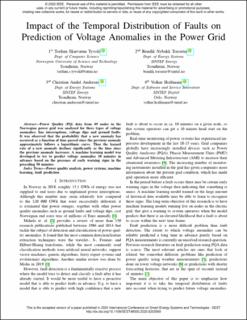Impact of the Temporal Distribution of Faults on Prediction of Voltage Anomalies in the Power Grid
Chapter
Accepted version

View/
Date
2020Metadata
Show full item recordCollections
- Publikasjoner fra CRIStin - SINTEF AS [5802]
- SINTEF Digital [2501]
- SINTEF Energi [1764]
Original version
2020 International Conference on Smart Energy Systems and Technologies (SEST). 2020. 10.1109/SEST48500.2020.9203569Abstract
Is it possible to reliably predict voltage anomalies in the power grid minutes in advance using machine learning models trained on large quantities of historical data collected by power quality analysers (PQA)? Very little previous research has been done on this topic. To investigate whether this is possible a machine learning model was developed that attempts to predict voltage anomalies 10 minutes in advance based on the presence of early warning signs in the preceding 50 minutes. The model was trained on voltage data collected from 49 measuring locations in the Norwegian power grid. Although results were inconclusive, it was observed that the time that has passed since the previous fault at the same location is a major factor to consider when estimating the probability that a new fault is imminent. It was observed that the probability that a new fault is imminent is proportional to the logarithm of the time passed since the previous anomaly. This means that the risk of a new anomaly is drastically reduced as more time passes since the previous anomaly. This is important to take into consideration when attempting to develop a model that estimates the probability that a new fault is imminent.